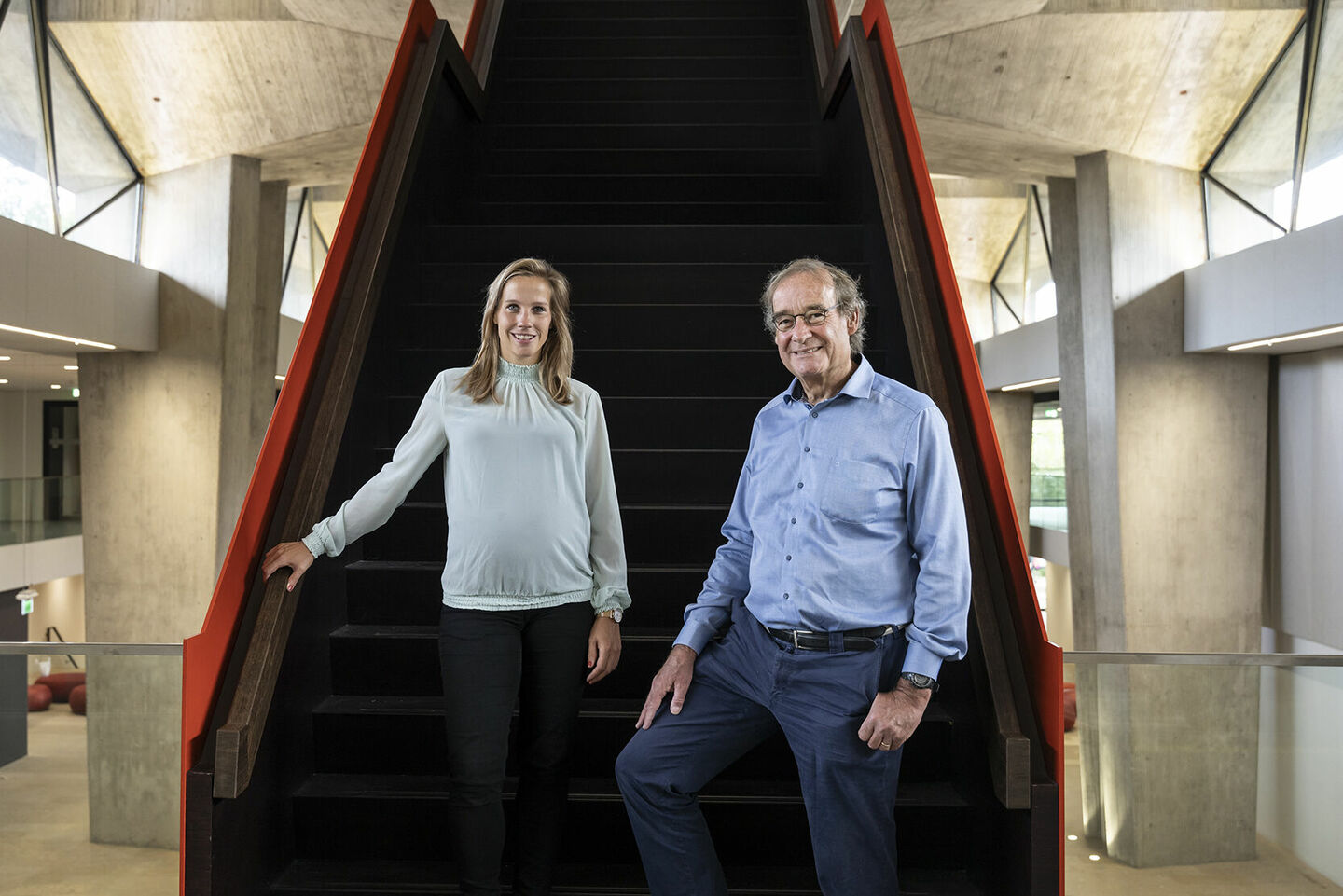
Progress that makes the planet a better place
Joint interview with Tessie Hartjes and Harry Otten
There is about forty years between them, yet they cannot stop talking to one another. Tessie Hartjes and Harry Otten are entrepreneurs in heart and soul: Hartjes is in sales and marketing at Lightyear, and Otten founded Meteo Consult and is co-owner of his new company Weather Solutions. Their shared ideal is a world in which growth and sustainability reinforce each other. Technology is the means to that end, and this is precisely why both alumni are still involved with the TU/e. Hartjes is a board member of the University Fund and Otten is currently engaged in talks with the university to start coaching enterprising alumni.
Heroes past and present
The theme of this lustrum year, which marks TU/e’s 65th anniversary, is ‘Heroes like you.’ In keeping with this theme, Cursor will publish a series of double interviews throughout the year with the motto ‘Heroes Past and Present.’ TU/e employees and students with proven track records, still working at the university or no longer under employment, are matched with their counterparts from today. In all possible fields: science, policy, or student life. In this episode, we give the floor to Tessie Hartjes and Harry Otten—alumni, entrepreneurs, and idealists with a passion for sustainable energy.
At the time of the interview, Tessie Hartjes (31) is 37 weeks pregnant. "I am actually not supposed to be working anymore.” She looks fit and relaxed. "I have been through so much with Lightyear that I am not really worried about the pregnancy." Lightyear is that company with the solar powered electric cars. The company is a derivative of the TU/e student Solar Team and entered the market this year. Tessie’s focus is on sales and marketing.
The tall Harry Otten (73), former RTL4 weatherman and founder of Meteo Consult, still knows his way around the campus. "Here in the Auditorium, I used to sit and do my calculations at the end of the week, waiting for the train to Breda." He studied Applied Physics: "My parents really wanted me to study something difficult, preferably at that new Brabant institution, the TH in Eindhoven."
By his own admission, Otten was not the best of students and a “true nerd”. Three days after graduating, he got married, as was customary at the time. "I have dedicated the rest of my life to my personal revenge of the nerds", Otten concludes with twinkling eyes.
Hartjes, in contrast, was not a bookworm, but an active student who moved on from the anniversary committee into the student team Blue Jay, as a member of which she contributed to the development of a drone that can offer help in case of emergencies, such as fire or missing persons.
Women
Within her bachelor’s degree in Sustainable Innovation, Hartjes chose to focus on energy. "Although I first wasted a year taking another direction. Whilst sustainable energy immediately had my interest, it was also known to be the most difficult choice. I felt insecure about whether I would be able to do it.”—something that now seems odd as, from a young age, she had actually been taught to take on challenges.
"My parents instilled confidence in me: ‘Just try it and if it does not work out, we will be there for you.' That has been the case ever since I chose the Natural Sciences and Health at high school. My mentor called my parents to ask whether they thought it was a smart decision, as I was better at languages. My mother responded: If you can do something already, what would be the challenge?” The idea that women are less good at technology is deeply ingrained in Western European culture, Tessie observes whilst adding: "And that whilst there is absolutely no biological ground for this."
Harry agrees: "The cultural attitude in the Netherlands is that women cannot do it. I do not believe that at all. I have seen so many capable female scientists at work during my visits to technological companies and organisations—such as CERN—all over the world."
Hartjes continues: "Yet I did end up doing something for a year that did not sit well with me, simply because I was too insecure about my own abilities to pursue what I really wanted. Girls look for certainty and only start something when they are certain they can actually do it. Because of my own experiences, I find it important to talk about this, for example at information activities for VHTO (National Expert Organisation on Girls/Women and Science/Technology, ed.), or in discussions with young women who are choosing their studies—colleagues and contacts sometimes ask me to take their daughters for a coffee.”
Grim
Both Hartjes and Otten are ardent advocates of sustainable energy. As a meteorologist, Otten sees climate change unfolding before his very eyes whilst, with Lightyear, Hartjes brings an electric car to the market that runs partly on solar energy.
How do they envision the future of our planet, in the light of the new IPCC climate report, to which TU/e professor Heleen de Coninck also contributed?
Otten: "I am pessimistic: There are way too many countries that are doing far too little to stop climate change. The report mentions a temperature increase of one and a half degrees; I would not foreclose the possibility that the earth will become three to four degrees warmer."
According to the IPCC report, sea levels will rise about seventy centimetres by the end of the century. "However," Otten warns, “it will not stop there. Even if we become completely CO2-neutral, sea levels will continue to rise throughout the 22nd century. Seawater is getting warmer and therefore expands."
If we succeed in unravelling the secret of nuclear fusion, we will be living in a world without CO2 concerns at the end of this century
Otten considers an eventual sea level rise of three to six metres. He sketches a grim picture of the year 2200, with two gigantic dikes that must keep the North Sea at bay: one in the north between Scotland and Norway, and one in the south near the English Channel, not to mention the drastic measures that the Netherlands will have to take where the rivers are concerned.
Hartjes counters this with an optimistic view of mankind: "I believe in mankind's urge to survive. There will always be disasters and developments that are 'harassing' us, but, for example, we have also succeeded in reducing the hole in the ozone layer above Australia. I definitely do not think it will happen overnight, but I do believe we can overcome climate change.”
"Do you think humanity will still exist in a thousand years?" Otten asks. Hartjes thinks so. "Even if there have been so many causalities that we will have been reduced to a single colony—from which we can start rebuilding." Otten's own vision of the future is much darker: "I doubt that there will be any people left. There is such an urge amongst all kinds of groups of people to destroy each other."
Nuclear Fusion
Despite his apocalyptic view of the future, Otten is committed to the sustainable energy transition. How does he reconcile the two? "Oh, but I absolutely do believe we will solve the energy issue this century. If we succeed in unravelling the secret of nuclear fusion—also the subject of groundbreaking research at the TU/e—we will be living in a world without CO2 concerns at the end of this century. There is no guarantee that it will work, but we do have to aim for it.”
And until that time comes? "With nuclear power plants we can bridge the gap, but then we do have to let go of the idea that nuclear power is 'terribly dangerous'. Times have changed since the Chernobyl disaster in 1986—China’s coal mines have more causalities in a single day than nuclear power has had during recent decades."
Hartjes agrees: "In addition, isn't one in eight deaths worldwide linked to air pollution from coal-fired power plants?". She too is not immediately averse to nuclear power plants as a bridge to types of sustainable energy that are not yet possible or commercially viable.
Otten struggles with what he considers the illogical choices that governments are currently making when it comes to energy: The Netherlands wants to abandon its relatively clean natural gas too quickly, and Germany is closing nuclear plants whilst polluting lignite plants are still smoking and CO2 emissions have risen for the first time in years there. "Meanwhile, vast forests in countries such as Estonia are cut down in favour of so-called CO2-neutral biomass. I cannot understand that."
As far as Hartjes is concerned, there is more to dream about than nuclear fusion alone: "With Lightyear, we want to aim for a car that you only have to charge once or twice a year." Otten pricks up his ears. "I did consider an electric car myself—a Lightyear even—but I own a second house in the south of France, and there are far fewer charging points there. Hartjes nods: "Of all the charging points in Europe, a quarter are located here in the Netherlands. However, a Lightyear would be very suitable for you in that case, because there is plenty of sun in the south of France."
Hydrogen
"Don't you think that hydrogen is the future for cars, rather than electricity?” suggests Otten, playing devil’s advocate. Hartjes laughs, because as the face of Lightyear, she has had what she refers to as this "endless discussion" more often. "I say: The future is electric. Unlike hydrogen, electricity is location independent: Eighty percent of the world's population has access to a wall socket. This is also why, for example, mobile telephones are widespread across Africa, whilst the landline telephone has never gained a foothold there."
However, both agree on the great advantage of hydrogen: that you can store energy in it. For example, Australia converts its surplus solar energy into hydrogen, which it subsequently exports to Japan. That is advantageous in the energy trade. Currently, the prices of wind and solar energy plummet when there is a local surplus. Northpool, one of the companies with which Otten is involved, responds to the constant fluctuations in supply and price of these energy sources.
Most of his attention, however, goes towards the start-up, Weather Solutions. The company provides targeted, local weather forecasts: How much solar radiation can Dutch greenhouse growers expect? Which roads in a particular German region need salt to mitigate slippery conditions?
"Meteorology has become very good at predicting the weather. The next step is to translate these weather models locally into the consequences per location. Extreme weather conditions are becoming more frequent, and people want to know: What does this mean for me and for my company?"
Luckily, renewable energy resources can collect local weather data. For example, Otten is trying to track down the manufacturer of his solar panels, who has the figures on solar radiation on countless roofs. The smart software in electric cars collects information on, for example, the temperature of the road surface—data that Lightyear can also start sharing, says Hartjes: "The ambition is that eventually hundreds of thousands of Lightyears are driving around—a potential treasure trove of data."
Kept Small
The longer Hartjes and Otten talk, the faster the ideas flow back and forth. Unfortunately, they both experience the politico-economic climate in the Netherlands and Europe as not ideal for innovative entrepreneurs.
"You are kept small here," says Hartjes. "Europe is a fragmented continent, of small countries that each have their own individual interests. Areas that otherwise would be good for Lightyear are therefore often lobbied out of reports and legal texts."
In addition, subsidy programmes and similar instruments often do not match practice, she adds. "Then you have to apply for one specific project, whilst you a) do not work on a project, but on a product; and b) you want to explore several ideas at once through parallel innovation. Or, as a start-up without capital, you are expected to double the grant amount yourself."
"It is hopeless," agrees Otten. At the time of Meteo Consult, he still managed to get a million from the bank on his own merits. "As long as you are still in the phase of development, you get nothing. Europe is not in favour of creating winners. In the US, investors are much more willing to take losses first before they start earning from you."
Hartjes concurs, explaining that in the Netherlands, the government and banks are not the places to go. This contrasts sharply with, for example, the five hundred million dollars that Tesla received from the American government. Fortunately, our country is rich in capital and does have private investors, which has enabled Lightyear to raise the required millions. Conversely, Otten invested his own capital in new companies, which he earned from the sale of his shares in Meteo Consult.
Yet America is not beckoning. "Not for now, at least", says Hartjes, who lives in Eindhoven with her partner, Lightyear-CEO Lex Hoefsloot. This somewhat to the surprise of the international workforce: "Lightyear has about 200 employees, with 27 different nationalities. They find Eindhoven very far from Amsterdam. Being able to work from home is a good solution, thankfully." Otten shakes his head at the idea that many still consider Amsterdam to be the Valhalla. "Brabant is becoming an increasingly interesting area."
A Better World
The TU/e is one of the driving forces behind the innovation power of the Brainport region. Considering this, does the university give enough attention to substantiality? “They are making the switch,” Hartjes observes. "You see the subject reflected in the case studies discussed on the open days and in the compulsory bachelor courses. And look at the student teams, they all have an intrinsic drive to make the future better. They don't go for the fastest possible car, but for one that can race as sustainably as possible."
This intrinsic drive characterises both Hartjes and Otten. A desire for growth, whilst at the same time benefiting the planet—something they believe is possible. "For example, by making electric transport so cheap that it becomes available to everyone worldwide," Hartjes asserts.
She and Lex would like to have more children, "but I am still considering whether that is the best thing to do from a sustainable perspective. We would like to leave the world a better place than it was. Otten prefers to see it the other way around: "With what you will teach your children, you contribute to a better world with a large family.”
This is a good moment for the interviewer to say goodbye. However, both entrepreneurs remain seated, as there is still much to discuss. "I have had an interesting idea for Lightyear for some time now", Otten begins.
University Fund Eindhoven
"As a student, I saw the University Fund (UFe) as 'that club where you could apply for money for a study trip'. Then we got a flag from the fund to take with us," Tessie remembers. Only later did she become aware of the other things that UFe does, such as financing research and stimulating talent development (see Heroes for Heroes). "This is exactly why I am involved in the fund as a board member. And perhaps I also see it as my task to rebrand the UFe amongst the students."
Harry still remembers how, as a second-year student, he went on an excursion to the Natlab—not the name of a film house at the time, but a Philips laboratory: "I saw researchers there send a signal via optical fibres from one side of the room to the other. That was something amazing, everyone was very excited. The fact that fibreglass now sends the same signals under the oceans is almost unbelievable." The fact that such developments are taking place in Eindhoven—and that he holds warm feelings towards his alma mater—means that Harry is happy to support the TU/e financially, although he hastens to say that the amounts are but a mere drop in the ocean. He is also currently talking to the university about the possibility of becoming a coach for TU/e alumni with a tech start-up in the Brainport.
The interviewees
Tessie Hartjes was born in Winterswijk in 1989. In 2008 she chose not to study in Twente, but at Eindhoven University of Technology, where she followed the bachelor programme Sustainable Innovation. As a student, amongst others, she was active in the anniversary committee and Eindhoven Student City. She was also one of the founders of student team Blue Jay in 2015.
Hartjes followed the master programme Electronics and Electrical Engineering, but for various reasons did not complete her degree. She started working for Lightyear temporarily when her boyfriend, CEO Lex Hoefsloot, spent several months in the US—and this worked out extremely well. In addition, her father died, which turned her world, including her previous priorities, upside down.
Hartjes continues to work at Lightyear in marketing, sales, and investor relations. The desire to finish her master's degree still sparks regularly—perhaps maternity leave will give her the opportunity to pick up the course material again.
Harry Otten was born in 1948 in Breda. Between 1967 and 1973, he studied Applied Physics at what was then still known as the THE. Otten, who was always fascinated by the weather as a child, started working at KNMI in 1975. After all, that was where you worked if you wanted to do something with meteorology in the Netherlands.
Five years later, during a sabbatical at Penn State University, he learned of the existence of private meteorological companies. A seed was planted, which grew into Meteo Consult in 1986. When the company grew from five to three hundred employees, Otten sold his shares in Meteo Consult between 2005 and 2011.
He put a portion of the proceeds into a foundation that awards the Harry Otten Prize for Innovation in Meteorology every other year. Further, as entrepreneurial blood never stops flowing, Otten started a new company, Weather Solutions, in 2017.

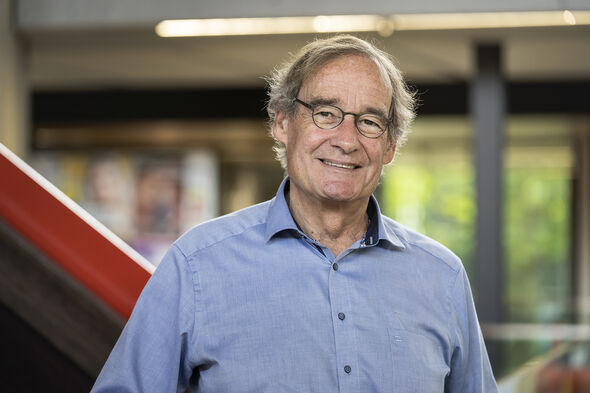

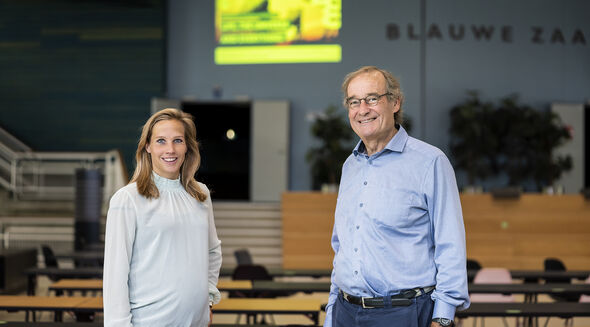
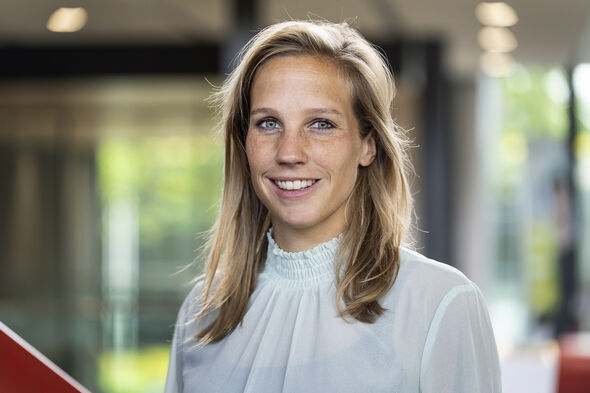
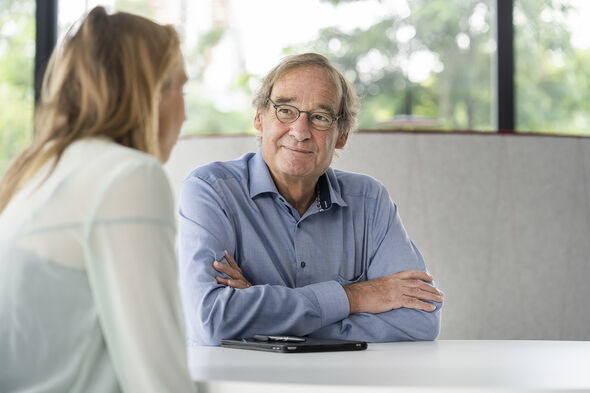
Discussion